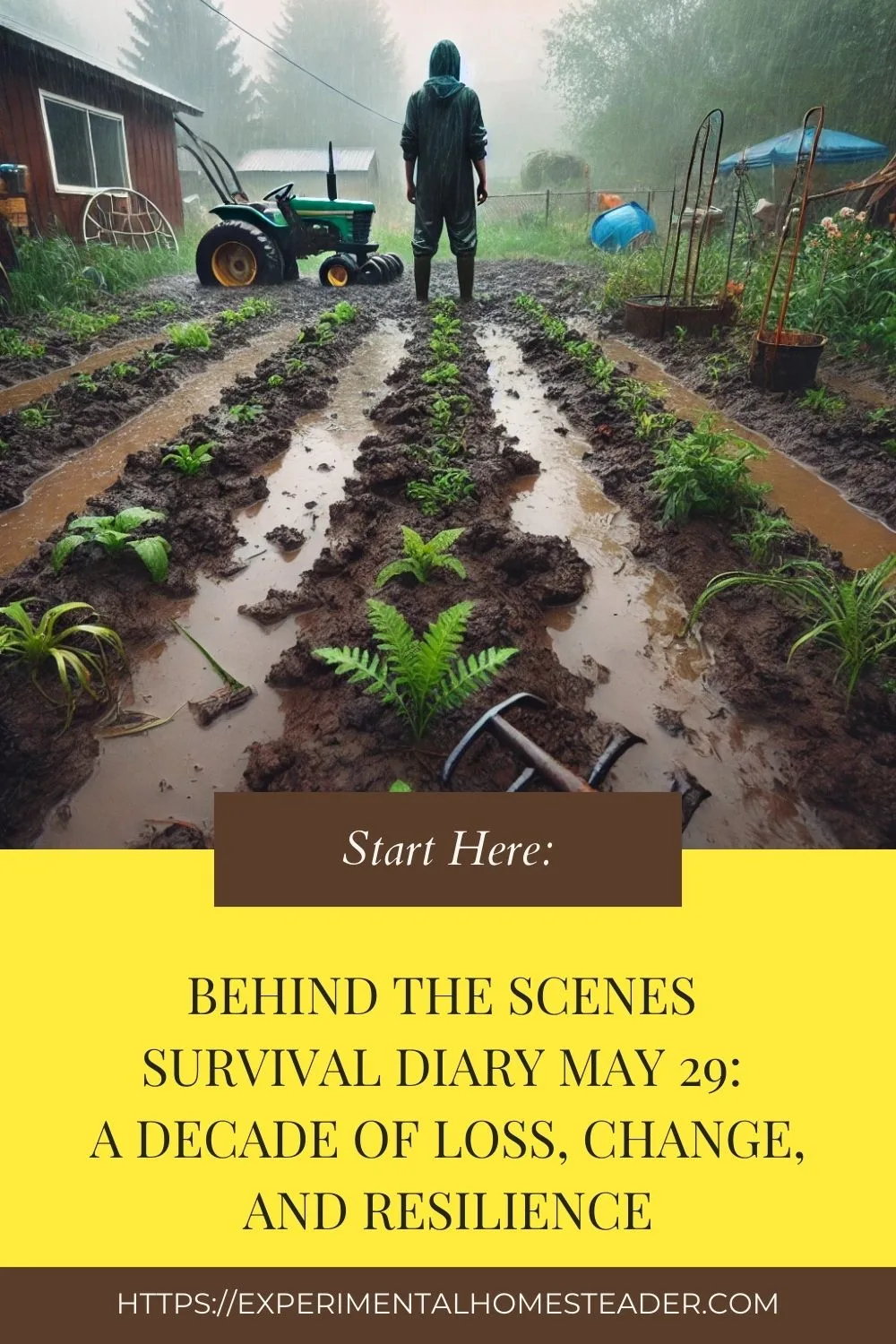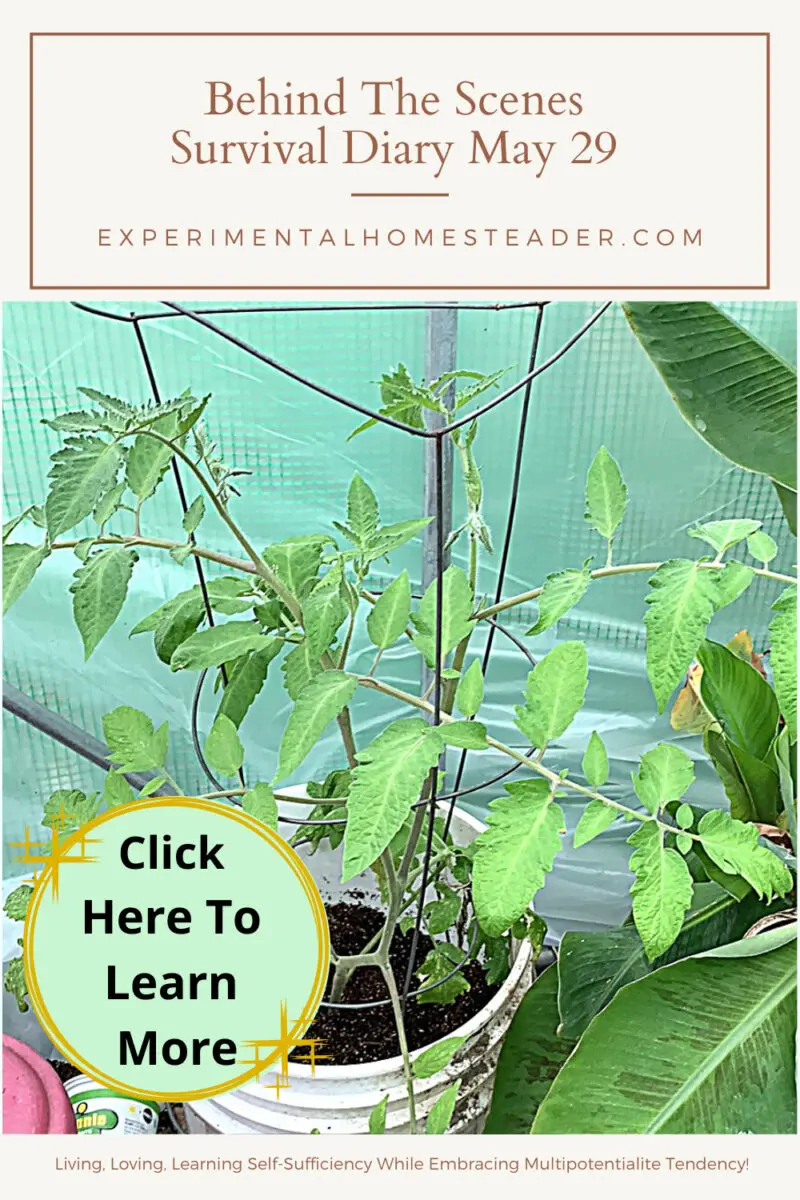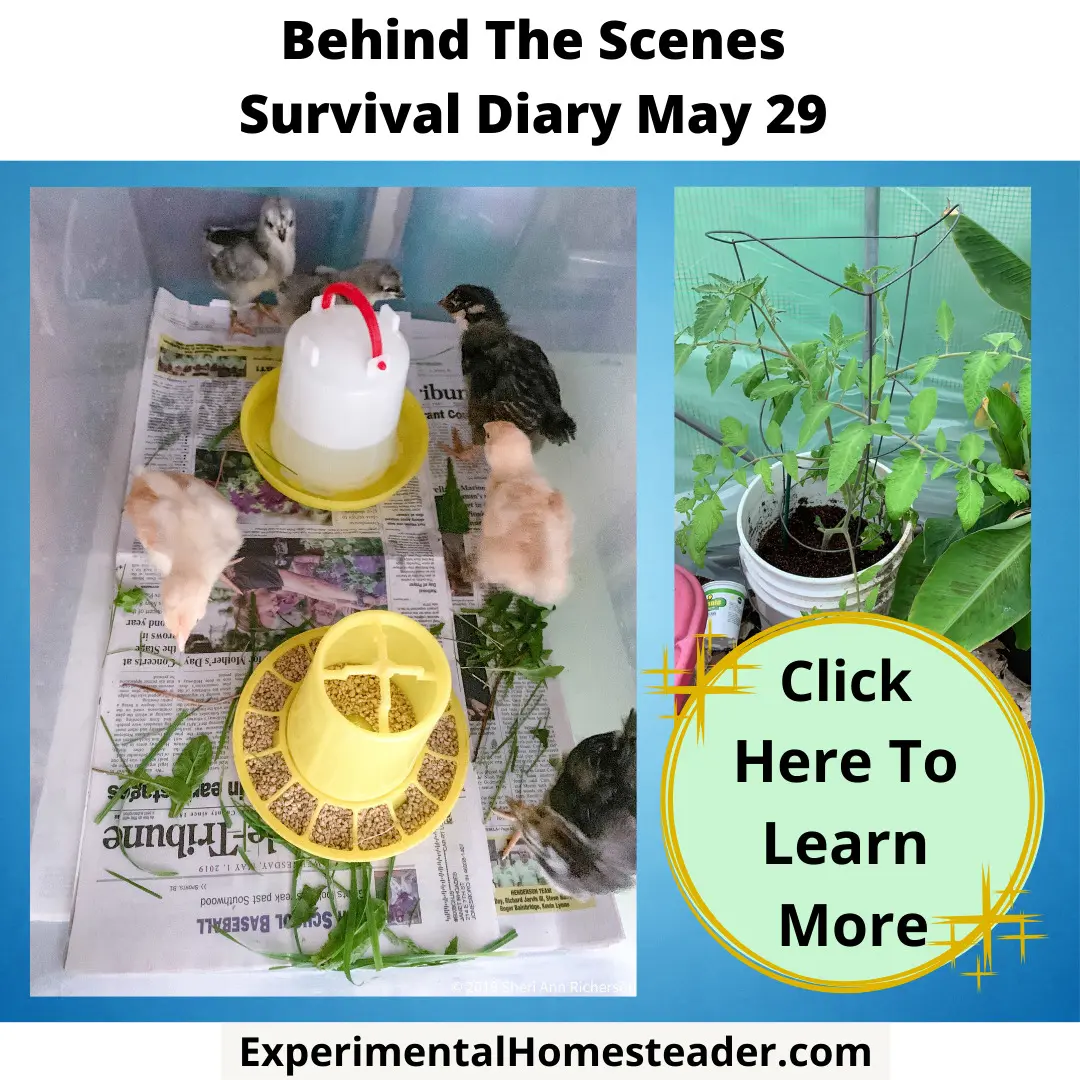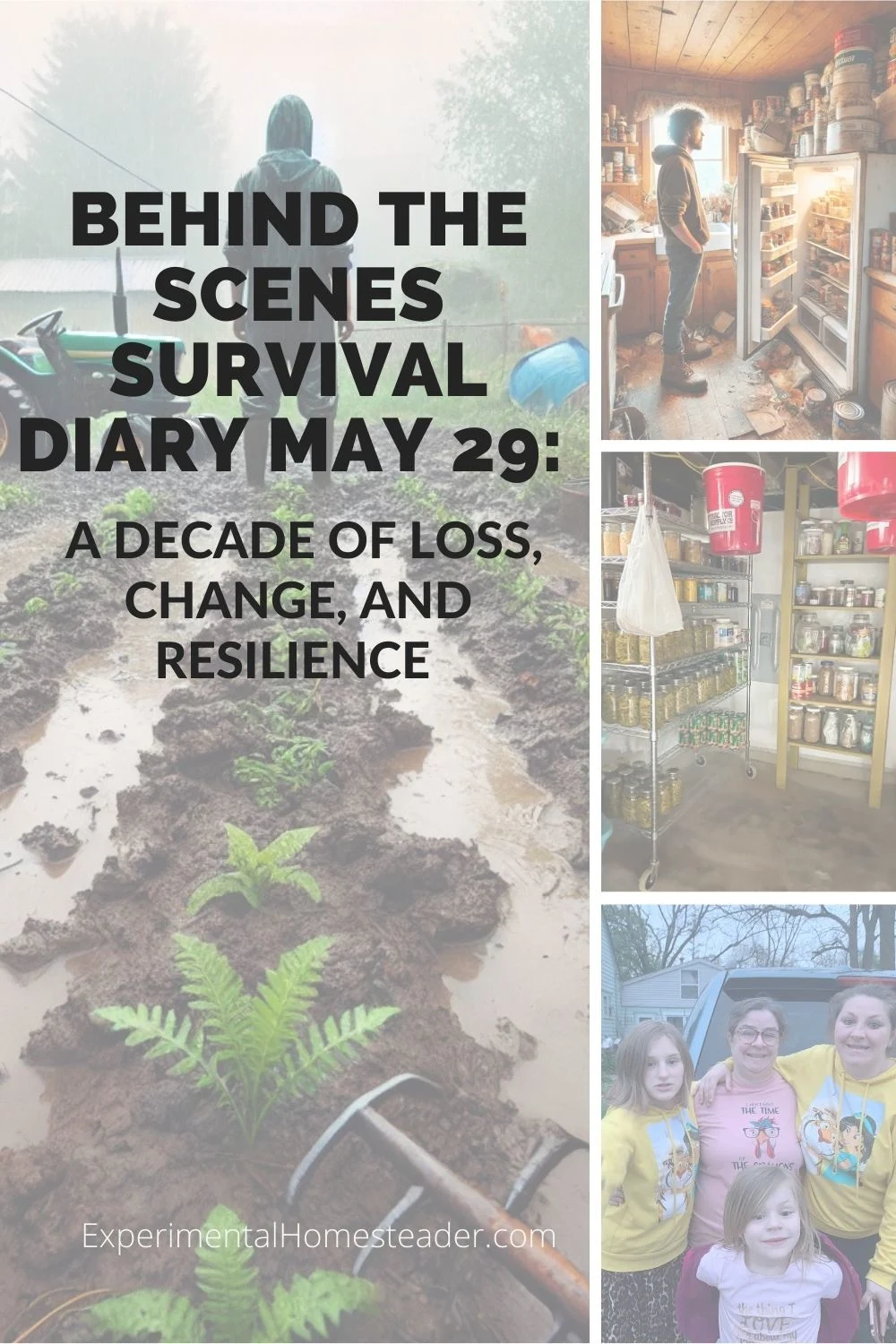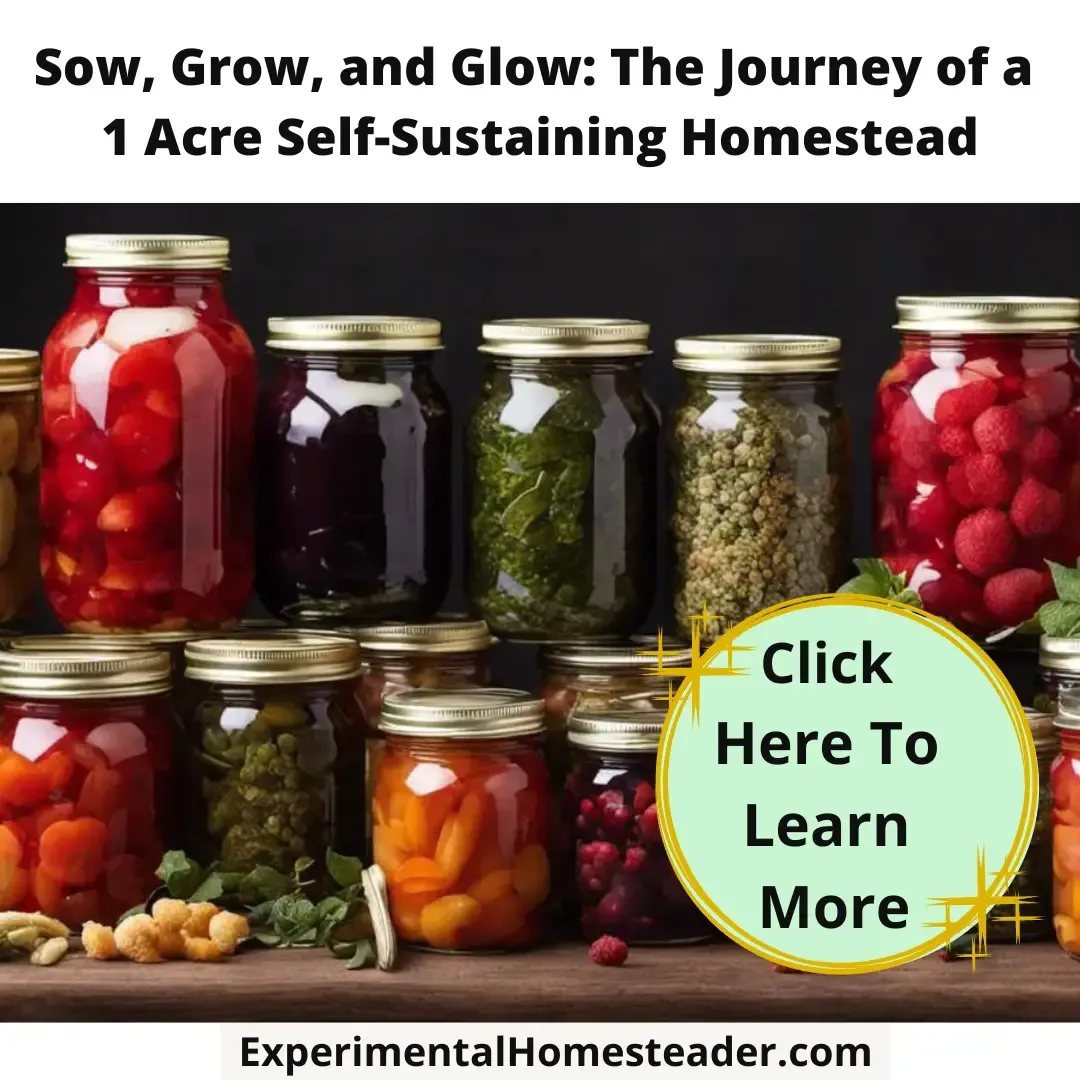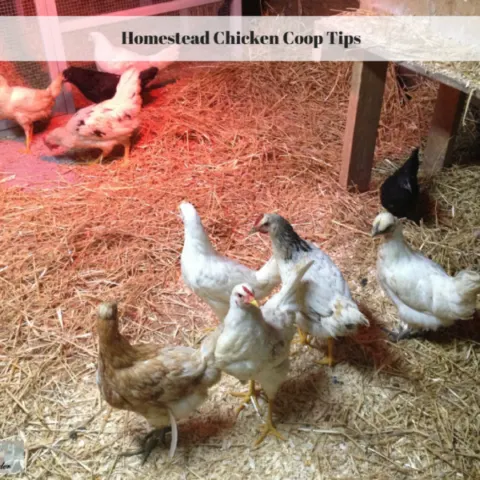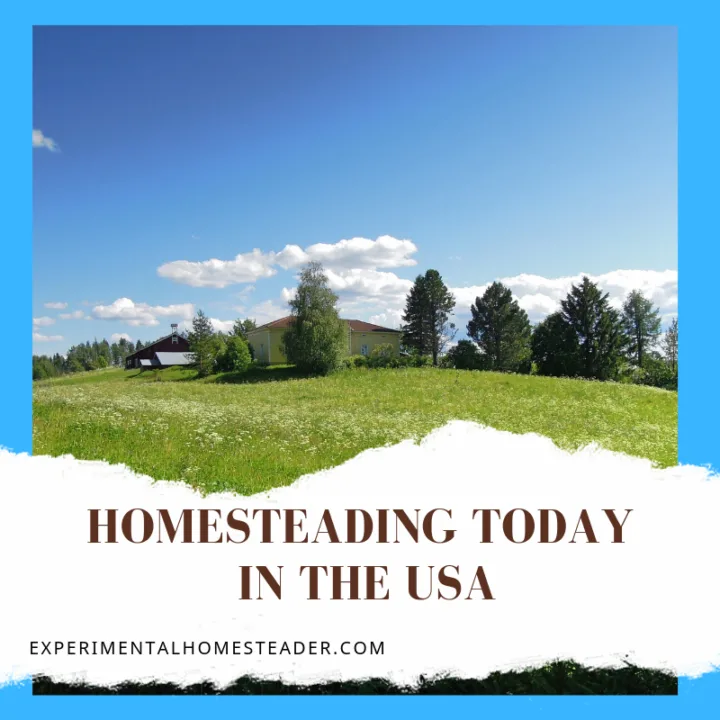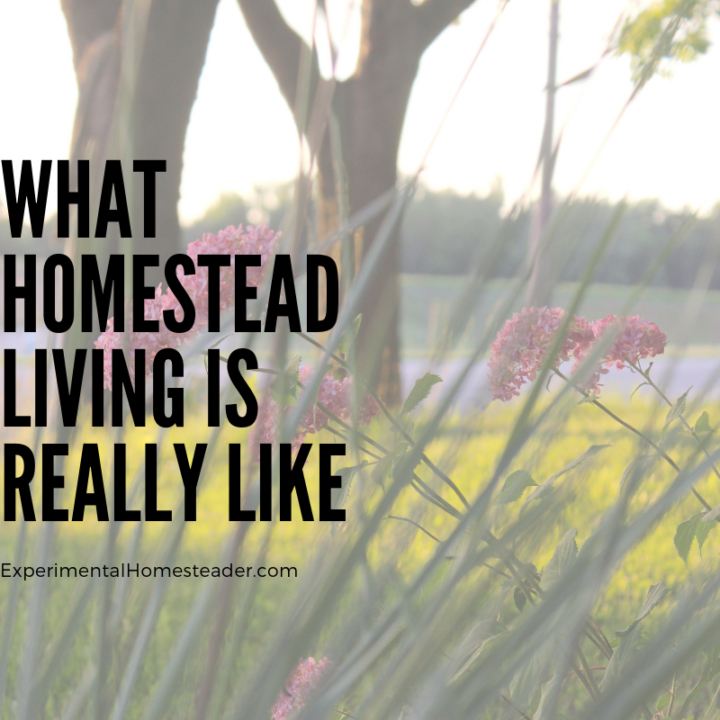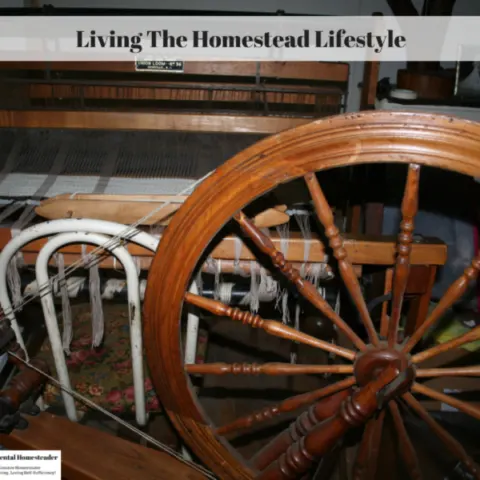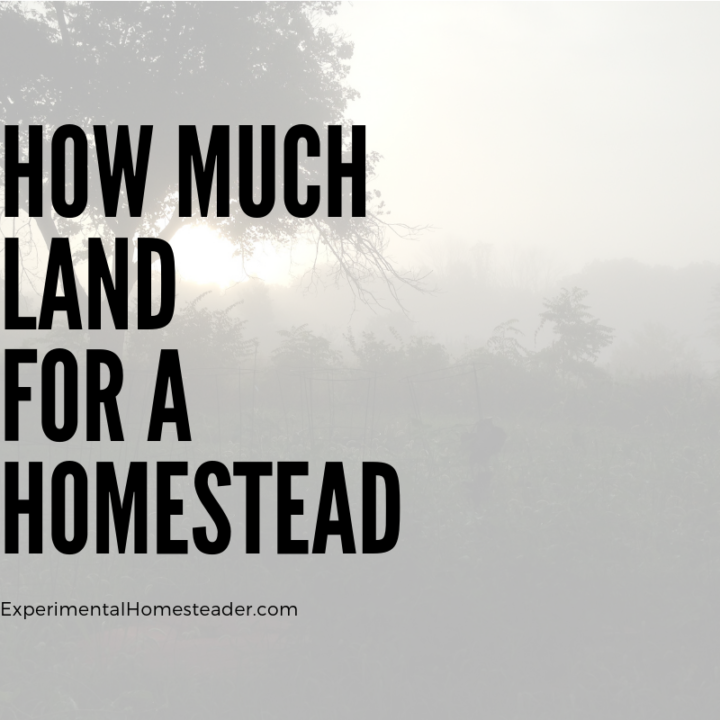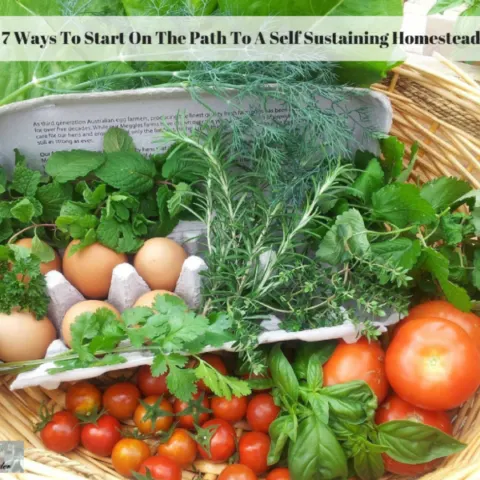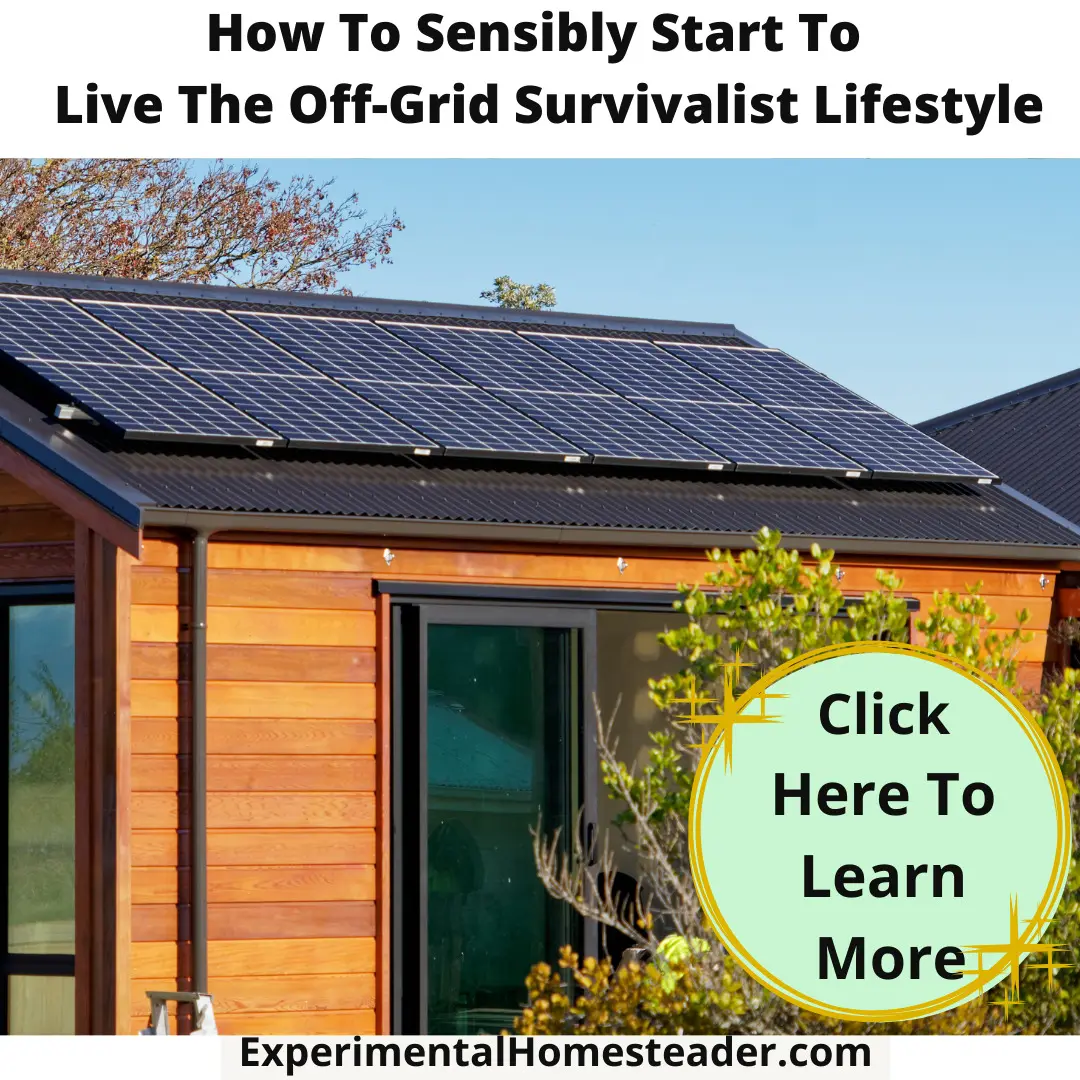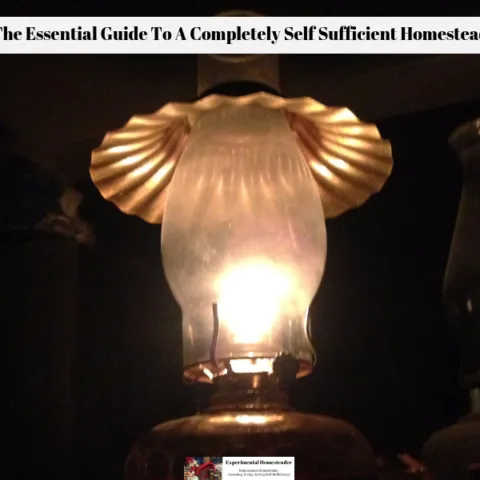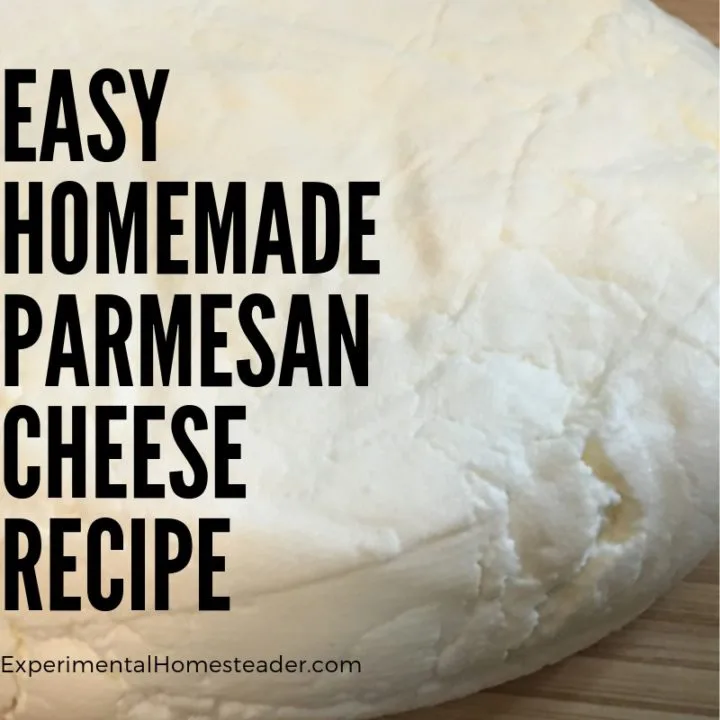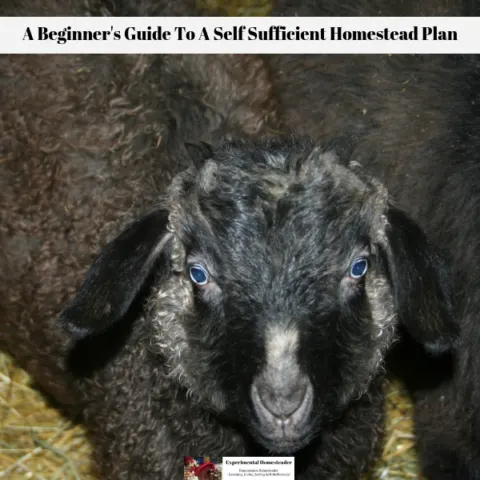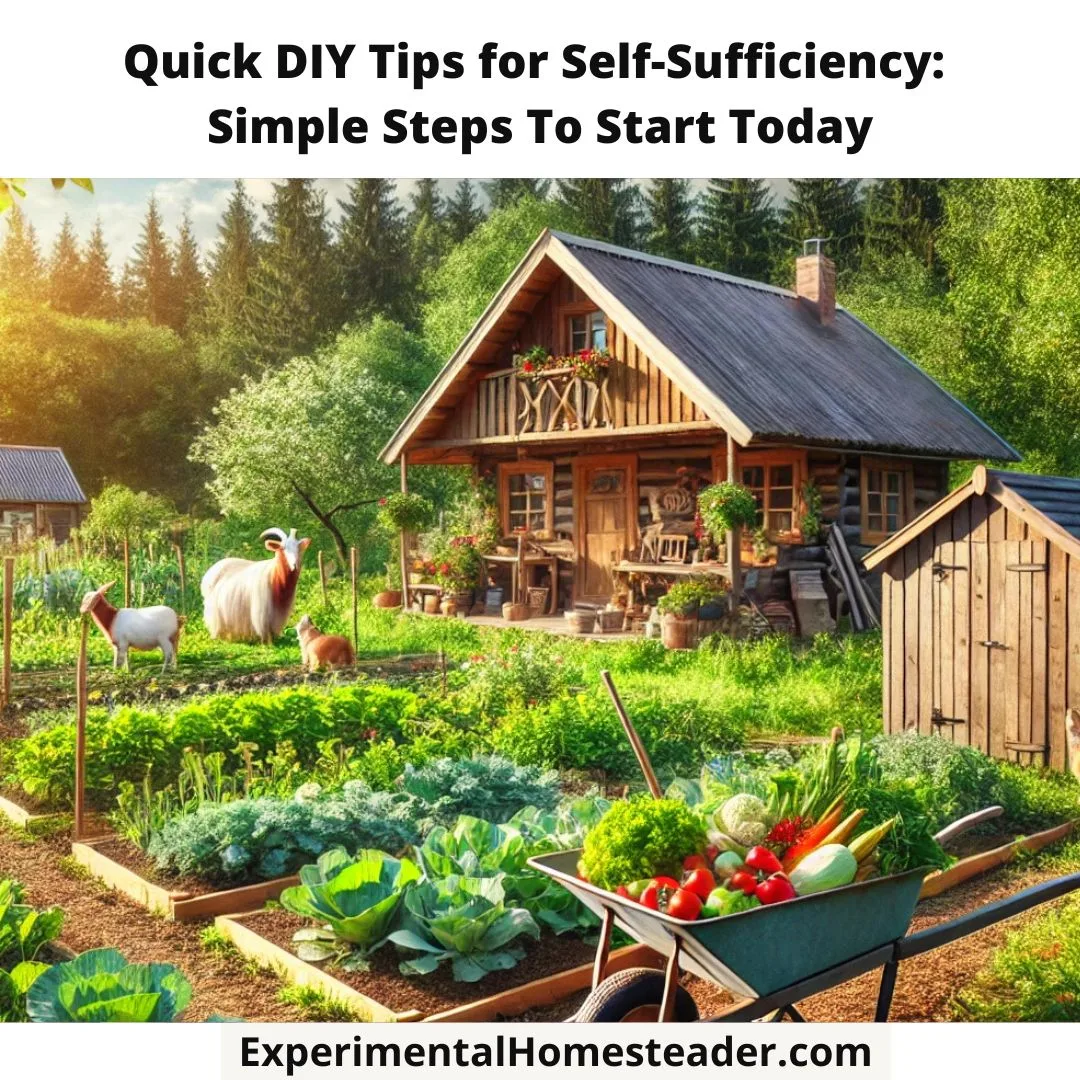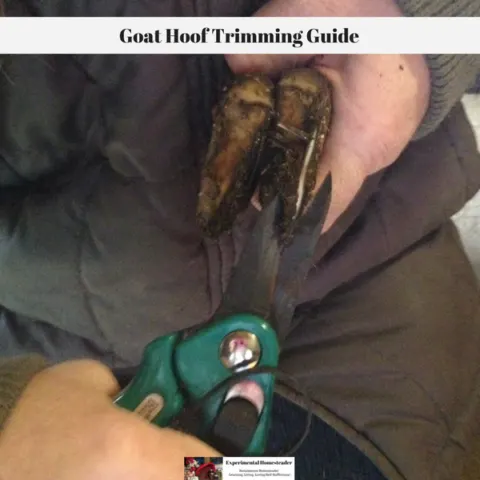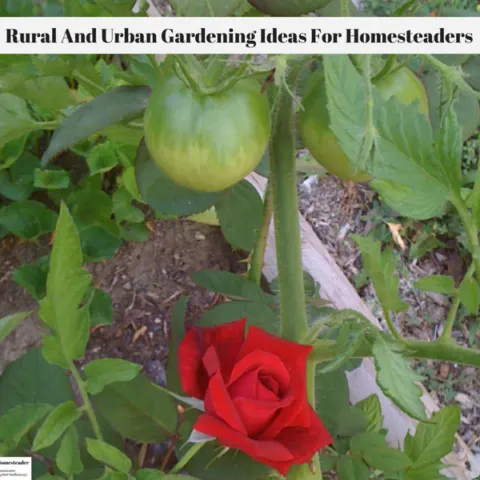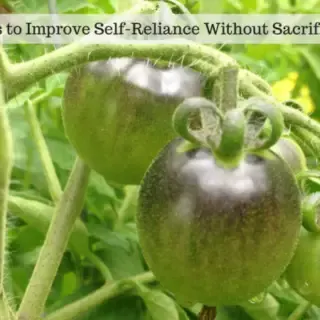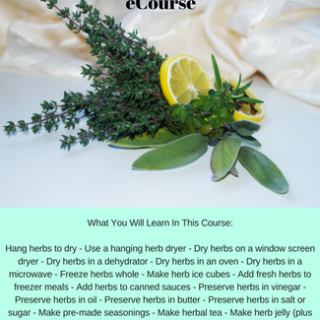Content Warning: This post includes personal experiences, including loss, food insecurity, and struggles with homesteading challenges. Some descriptions may be difficult to read. Please proceed with care.
Welcome to the survival diary May 29.
As some of you know, in late 2013 my life was turned upside down by the very unexpected death of my then husband Jerry Stanley.
It felt like I was strapped into an emotional roller coaster that never let me off—keeping me suspended upside down just long enough to break me before flipping me upright again, only to drop me back into chaos.
I did remarry shortly after he died, and while it wasn’t under the best circumstances, given everything I was going through, it’s the one thing that kept me holding on.
It is however, a decision I do not regret.
And now, more than a decade later, it finally feels like some kind of normal is returning—not just to my life, but to the homestead as well.
Well, except for this cold, rainy, absolutely relentless weather.
The Weight of a Decade
Grief isn’t a single moment.
It doesn’t strike once and disappear.
It lingers.
It weaves itself into the fabric of your life.
When my husband died in 2013, I lost more than a person.
I lost the life I thought I’d have.
I lost the plans we made, the future we imagined.
And in its place, I was left with something I hadn’t expected—an emptiness that no amount of preparation could have filled.
I remarried, and that marriage held me together when I might have otherwise crumbled.
But the truth is, loss changes you.
It makes you see life differently.
It teaches you that nothing is guaranteed.
I carried that lesson into my homesteading journey, into every decision I made.
And here I am, over a decade later, still holding on, still fighting for the life I want, even when the odds seem stacked against me.
Gardening Delays, Weeds, and Unpredictable Weather
Jeff was able to get out a few weeks ago and rototill the small garden—twice.
But it needed it a third time.
You’d think, after all these years, the land would start working with me instead of against me.
But no.
It fights me at every turn.
The creeping Charlie, the thistles, the weeds that choke out every inch of soil before I can even plant a seed—they aren’t just obstacles.
They’re reminders.
Of the years my neighbor let his land go wild.
Of the way one person’s neglect can leave scars that last for years.
Of how nature always finds a way—whether you want it to or not.
It would be easy to give up.
To say, “This year, I just won’t plant.”
To let the weeds win.
But that’s not who I am.
So, I wait.
I battle the rain.
I fight back against the creeping, the smothering, the relentless takeover of what should be my garden.
Because eventually, the rain will stop.
The soil will dry.
And I’ll plant anyway, all the while being grateful I have new neighbors who are managing to get control of their land and get rid of the noxious weeds from the previous owners.
Because that’s what survival is.
Not giving up when everything says you should, and remembering to be grateful for every step in the right direction, knowing is it a sign you are on the right path.
The Big Garden Expansion
This year, I decided to expand the big garden.
Jeff estimates it’s now around 70 feet by 70 feet—which is still small for everything I want to grow!
He got it rototilled once before the rain hit, and now it’s just sitting there, full of grass and thistle, waiting for two more passes with the tiller before I can plant.
The worst part?
This battle isn’t even my fault.
The previous neighbor let his acreage go wild—poison ivy, thistles, and other weeds set seed for five straight years, and all of it blew onto my land.
Weed seeds can stay dormant for seven years, so even though that property has new owners who are finally cleaning it up, I’m still stuck fighting the consequences.
A Backup Plan for Planting
The good news?
My seedlings are waiting patiently in the greenhouse.
The bad news?
If this rain doesn’t stop soon, I’ll be forced to lay clear plastic over the garden to kill off weeds and dry it out before I can even think about planting.
Because working clay soil when it’s wet?
That’s a one-way ticket to rock-hard, brick-like dirt.
And after everything I’ve done to improve my soil, I refuse to ruin it now.
I did plant one tomato plant in a five-gallon bucket because I’m impatient—and it’s already flowering like crazy, so at least I’ll have tomatoes soon.
But I wanted to start more plants in buckets, and here’s a fun surprise—bakeries don’t give away free buckets anymore.
Many won’t even sell them.
I could buy buckets, but I’m not spending money on that right now.
So, for now, I wait.
And if I have to, I’ll pivot—because I’m not about to let another gardening season pass me by.
New Baby Chicks and a Much-Needed Coop Renovation
Six baby chicks sit in a brooder in my living room, cheeping softly, oblivious to the world outside.
They don’t know that just beyond these walls, predators lurk.
That raccoons, foxes, and groundhogs would tear them apart in seconds if given the chance.
They don’t know the old coop is falling apart, that the place they were supposed to call home isn’t ready, that I’m scrambling to make a new space for them before they outgrow their temporary shelter.
But I know.
I know what it feels like to fight for safety in a world that wants to rip you apart.
And maybe that’s why I fight so hard to keep them safe.
Because in a way, I see myself in them—small, fragile, vulnerable.
And yet, with the right care, with enough protection, they’ll grow strong enough to survive on their own.
They just need time.
And I won’t let the world take them before they get it.
The Refrigerator Disaster: Learning to Survive Without It
It was brand new.
Delivered on December 23.
And by May, it was already broken.
The freezer went first, silently ruining everything inside.
Then the fridge followed, leaving me scrambling to save what I could, to figure out how to live without something I had taken for granted.
For days, I’ve been cooking without cold storage, rationing what’s left, making do in a way that people used to—but that modern life has made nearly impossible, especially with my daughter and grandkids here.
They expected to find a hoarder’s house—chaos, filth, empty shelves, starving people and animals.
But that’s not what they walked into.
Instead, they found a well-stocked pantry, shelves lined with home-canned and dehydrated food, and animals that were well-fed and cared for.
They came looking for neglect, for failure.
They came looking for neglect, for failure.
What they found was resilience.
Preparedness.
A way of life they didn’t understand.
Because this time, I was ready.
When I was 23, they took my kids—ripped them away with false allegations I didn’t know how to fight.
I was young, overwhelmed, alone, and completely unprepared to battle the system.
And I lost.
That loss never left me.
It shaped me.
It fueled me.
This time, when they showed up at my door, I wasn’t the scared young woman with four kids on her own that they once broke.
I was a woman who had learned, who had built something unshakable.
They expected to tear me down again.
But I refused to let history repeat itself—and in the end, they apologized.
Not that an apology could ever undo the damage, not just to me, but to my kids.
The system tore us apart, leaving wounds that still haven’t fully healed.
I’m still fighting to mend those relationships, to rebuild the trust that was shattered.
My kids grew up feeling abandoned and unwanted when that was never the truth.
And no apology can erase the years of pain, the struggle to prove that I never stopped loving them.
It’s a long battle, one that my adult kids and I fight every single day.
Trying to Make It Work Without Cold Storage
I’ve been waiting on the freeze-dried food I ordered, watching the tracking updates, hoping today will be the day it finally arrives.
And as frustrating as it is, it’s also a reminder:
Nothing is permanent.
Things break.
Plans fail.
Comforts disappear overnight.
And when they do, you either crumble… or you figure out how to survive without them.
This time, I wasn’t as prepared as I should have been.
Next time?
I will be.
Because survival isn’t just about reacting—it’s about learning, adapting, and being ready before the next disaster strikes.
The Lesson Learned
I need to can more ready-to-eat meals and stockpile more freeze-dried food—because if (or when) this happens again, I want to be better prepared.
The Reality of Homesteading: Always Expect the Unexpected
If there’s one thing 15 years of homesteading has taught me, it’s this:
- Things break at the worst possible time.
- People let things go, and you end up dealing with the aftermath.
- Plans fail. The weather doesn’t cooperate. Life throws you curveballs.
But giving up?
That’s not an option.
So I do what I always do.
I figure it out.
I adjust.
I push forward.
Because survival isn’t just about having food, water, or shelter—it’s about resilience.
And that?
That’s something I refuse to lose.
I used to think survival was about having enough.
Enough food.
Enough supplies.
Enough security to weather the storms.
But after everything—the loss, the setbacks, the endless unpredictability of life and homesteading—I know now that survival isn’t just about what you have.
It’s about what you refuse to lose.
Are you dealing with crazy weather delays, garden struggles, or unexpected homesteading disasters this year?
Let me know in the comments!
Let’s support each other through the chaos.
Homestead Lifestyle
Discover the joys and challenges of homesteading with our Homestead Lifestyle collection of posts. From growing your own food and raising animals to crafting DIY solutions and embracing sustainable living, these articles provide practical tips, inspiration, and insights to help you build a more self-reliant life. Whether you're starting small in your backyard or managing a larger homestead, you'll find everything you need to simplify, thrive, and reconnect with nature. Explore topics like gardening, food preservation, animal husbandry, and more to create a homestead lifestyle that works for you.
Cooking By Kerosene Lamp
There are many reasons you might find yourself cooking by kerosene lamp. Kerosene lamps have advantages over candles.
Homesteading Recipe Sharing: Connect, Preserve, and Inspire Through Your Favorite Recipes
Explore the significance of homesteading recipe sharing: from preserving traditions to connecting with others and sparking new ideas.
Diligence & Your First Homestead Property: An Essential Guide
Make your first homestead property a reality. Learn why diligence and a personal visit to the property are the foundations of success
Sow, Grow, and Glow: The Journey of a 1 Acre Self Sustaining Homestead
Create a thriving, 1 acre self sustaining homestead. Learn how to plan, design, grow food, and more with this guide!
Make Your Own Maple Syrup with the Maple Tapping Tree Kit
Discover the joy of maple tapping with the Maple Tapping Tree Kit. Elevate your homesteading with this practical kit.
Mastering the Art of Homesteading: Skills and Crafts
Explore the world of homesteading skills and crafts, from self-sufficiency to survival, and discover the art of self-reliant living.
DIY Guide: Building Your Goat Milk Stand
This guide will ensure you create a functional and comfortable milking platform for your goats.
Homestead Chicken Coop Tips
Check out these basic chicken coop ideas to help you get your homestead chicken coop set up right the first time and keep your chickens safe. #homesteadchickencoop #chickencoop #chickencoopideas #backyardchickens
From Dream to Reality: Start a Homestead with Zero Funds
Start a homestead with zero funds! Discover practical strategies for a budget-friendly, self-reliant lifestyle.
8 Things To Consider For A Survival Homesteading Property
If you're considering a survival homesteading property, here are the 8 factors to help you determine if it's right for your household.
Thriving Through Self-Sufficiency: A Journey to a Balanced Life
Learn how to thrive through self-sufficiency: slow down, live intentionally, and find balance for a healthier and more sustainable lifestyle.
Quick DIY Tips for Self-Sufficiency: Simple Steps To Start Today
Discover quick DIY tips for self-sufficiency, from gardening to food preservation, to build confidence and live sustainably today.
Preserving Herbs For Winter Use eCourse
Do you love fresh herbs but wonder if there is an easy way to preserve them for the winter?
Do you seek other ways to use herbs other than just as a seasoning on food?
There are so many ways to preserve herbs for winter use – from various methods of drying them to freezing them, but it doesn’t end there.
Some of the best ways to preserve herbs in right in the foods you would normally incorporate herbs into – pre-made seasonings, teas, butter or oil.
Then this is the course for you!
What You Will Learn In This Course:
Hang herbs to dry
Use a hanging herb dryer
Dry herbs on a window screen dryer
Dry herbs in a dehydrator
Dry herbs in an oven
Dry herbs in a microwave
Freeze herbs whole
Make herb ice cubes
Add fresh herbs to freezer meals
Add herbs to canned sauces
Preserve herbs in vinegar
Preserve herbs in oil
Preserve herbs in butter
Preserve herbs in salt or sugar
Make pre-made seasonings
Make herbal tea
Make herb jelly (plus tips on how to use these)
Harley-Davidson Motorcycle History How Legendary Harley Motorcycles Originated & Developed, Since 1903
The Harley-Davidson Company has a long history here in the United States. Learn how they originated and how they have been used.


